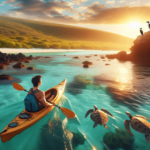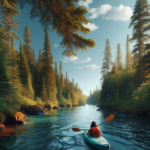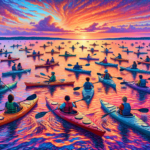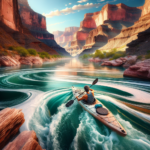Kayaking in Lake Tanganyika, Tanzania
Introduction to Kayaking
Kayaking is an exhilarating outdoor activity that has gained immense popularity worldwide. It offers a unique blend of adventure, exercise, and a chance to connect with nature. Whether you’re navigating through serene lakes, challenging river rapids, or exploring coastal waters, kayaking provides a thrilling experience that appeals to both beginners and seasoned paddlers. The sport’s versatility and accessibility make it a favorite among outdoor enthusiasts.
In this article, we will spotlight the unique features of Kayaking in Lake Tanganyika, Tanzania, a destination that stands out for its breathtaking scenery and diverse aquatic life. We’ll explore why this location is a must-visit for kayaking enthusiasts and provide detailed information to help you plan your trip. From the best spots to kayak to safety regulations and environmental considerations, we’ve got you covered.
Lake Tanganyika, located in Tanzania, offers a kayaking experience like no other. Its crystal-clear waters, surrounded by lush landscapes and teeming with unique wildlife, make it a paradise for paddlers. The lake’s vast expanse and relatively calm conditions provide an ideal setting for both leisurely paddles and more adventurous excursions.
What sets Kayaking in Lake Tanganyika apart is its unique combination of natural beauty, rich biodiversity, and cultural significance. As one of the oldest and deepest lakes in the world, it offers a kayaking experience steeped in history and natural wonder. Whether you’re a nature lover, an adventure seeker, or someone looking to unwind, Lake Tanganyika has something special to offer.
Overview of Kayaking in Lake Tanganyika, Tanzania
Lake Tanganyika is the second deepest and second largest freshwater lake by volume in the world, stretching across four countries: Tanzania, the Democratic Republic of Congo, Burundi, and Zambia. The Tanzanian portion of the lake is particularly renowned for its stunning landscapes and rich biodiversity. The lake’s clear waters are home to over 300 species of fish, many of which are found nowhere else on Earth.
The climate around Lake Tanganyika is tropical, with a wet season from November to April and a dry season from May to October. The best time to visit for kayaking is during the dry season when the weather is more predictable, and the waters are calmer. The lake’s temperature remains relatively stable throughout the year, making it a comfortable destination for water activities.
Historically, Lake Tanganyika has been a vital resource for the local communities, providing food, transportation, and a means of livelihood. While kayaking is a relatively new activity in the region, it has quickly gained popularity among both locals and tourists. The lake’s vast expanse and diverse ecosystems make it an ideal location for exploring by kayak.
Visitors can access Lake Tanganyika via several entry points, with Kigoma being the most popular. Kigoma is a bustling town with good transport links, including an airport and a railway station. From Kigoma, you can easily reach various kayaking spots around the lake. Whether you’re planning a day trip or a longer expedition, Lake Tanganyika offers a range of options to suit your needs.
Kayaking Conditions in Lake Tanganyika, Tanzania
Lake Tanganyika’s water conditions are generally favorable for kayaking. The lake’s vast size means that it offers a variety of paddling environments, from calm bays and inlets to more open waters. The water is remarkably clear, providing excellent visibility and a chance to observe the lake’s unique aquatic life up close.
The weather around Lake Tanganyika is typically warm and humid, with temperatures ranging from 24°C to 30°C (75°F to 86°F) throughout the year. The dry season, from May to October, is the best time for kayaking as the weather is more stable, and there is less chance of rain. During this period, the lake’s waters are generally calm, making it ideal for both beginners and experienced kayakers.
While Lake Tanganyika does not experience tides like coastal waters, it does have some currents and wind patterns that can affect kayaking conditions. The northern part of the lake tends to be calmer, while the southern part can be more challenging due to stronger winds and currents. It’s essential to check local weather forecasts and seek advice from local guides before heading out on the water.
Environmental factors such as water temperature and clarity can also impact your kayaking experience. The lake’s water temperature remains relatively constant, making it comfortable for paddling year-round. However, it’s always a good idea to wear appropriate clothing and bring sun protection, as the tropical sun can be intense. Overall, Lake Tanganyika offers a diverse and rewarding kayaking experience for paddlers of all skill levels.
Top Spots for Kayaking in Lake Tanganyika, Tanzania
One of the top spots for kayaking in Lake Tanganyika is the Mahale Mountains National Park. This park is famous for its stunning scenery, including lush forests, rugged mountains, and pristine beaches. Kayaking along the shores of Mahale offers a unique opportunity to see chimpanzees and other wildlife in their natural habitat. The best time to visit is during the dry season when the weather is more predictable, and the waters are calm.
Another popular kayaking destination is Gombe Stream National Park. Known for its connection to Jane Goodall’s chimpanzee research, Gombe offers a unique blend of natural beauty and scientific significance. Kayaking here allows you to explore the park’s secluded bays and inlets, providing a peaceful and immersive experience. The best time to kayak in Gombe is early in the morning or late in the afternoon when the wildlife is most active.
Kigoma Bay is another excellent spot for kayaking. Located near the town of Kigoma, this bay offers calm waters and easy access to various amenities. It’s an ideal location for beginners or those looking for a more relaxed paddling experience. The bay’s clear waters and sandy beaches make it a perfect spot for a leisurely day on the water. The best time to visit is during the dry season when the weather is more stable.
For those seeking a more adventurous experience, the southern part of Lake Tanganyika offers more challenging conditions. Areas like Kipili and Kasanga are known for their stronger winds and currents, making them suitable for experienced kayakers. These spots offer a more rugged and remote experience, with fewer tourists and more opportunities to explore untouched landscapes. The best time to visit is during the dry season when the weather is more predictable.
Safety and Regulations
When kayaking in Lake Tanganyika, it’s essential to adhere to local safety regulations and guidelines. Always wear a life jacket and ensure that your kayak is equipped with necessary safety gear, such as a whistle, a first aid kit, and a waterproof map. It’s also advisable to carry a mobile phone or a VHF radio for emergency communication.
Before heading out on the water, make sure to check the local weather forecast and be aware of any potential hazards, such as strong winds or currents. It’s also a good idea to inform someone of your planned route and expected return time. If you’re unfamiliar with the area, consider hiring a local guide who can provide valuable insights and ensure your safety.
In case of an emergency, it’s crucial to know how to handle various situations. If you capsize, stay with your kayak and try to re-enter it if possible. If you’re unable to re-enter, use your whistle or radio to signal for help. It’s also important to stay calm and conserve your energy while waiting for assistance.
Respecting local regulations and guidelines is not only essential for your safety but also for preserving the natural environment. Avoid disturbing wildlife and adhere to designated kayaking areas. By following these guidelines, you can ensure a safe and enjoyable kayaking experience in Lake Tanganyika.
Amenities and Accommodations
Lake Tanganyika offers a range of amenities to make your kayaking trip more enjoyable. Several rental facilities around the lake provide kayaks, paddles, and safety gear. These facilities often offer guided tours, which can be an excellent way to explore the lake’s best spots with the help of an experienced guide.
Accommodation options around Lake Tanganyika are diverse, catering to various budgets and preferences. From camping sites and budget lodges to luxury hotels and eco-friendly resorts, there’s something for everyone. Kigoma, in particular, offers a wide range of accommodations, making it a convenient base for your kayaking adventures.
For those who prefer a more immersive experience, several campsites around the lake offer a chance to connect with nature. These sites often provide basic amenities such as toilets, showers, and cooking facilities. Camping by the lake allows you to enjoy the tranquility of the surroundings and wake up to stunning views each morning.
In addition to kayaking, Lake Tanganyika offers various recreational activities for visitors. You can go hiking in the nearby national parks, enjoy bird watching, or take a boat tour to explore more remote areas of the lake. Whether you’re looking for adventure or relaxation, Lake Tanganyika has something to offer.
Environmental Considerations
Preserving the natural habitats and wildlife of Lake Tanganyika is crucial for maintaining its beauty and biodiversity. When kayaking, it’s essential to practice eco-friendly habits to minimize your impact on the environment. Avoid disturbing wildlife and refrain from feeding or approaching animals too closely.
One of the best ways to protect the lake’s ecosystem is by following the “Leave No Trace” principles. This includes packing out all trash, avoiding the use of single-use plastics, and being mindful of your impact on the environment. By practicing responsible kayaking, you can help preserve Lake Tanganyika for future generations.
Several local conservation efforts and projects aim to protect the lake’s unique biodiversity. These initiatives often focus on preserving fish populations, protecting habitats, and promoting sustainable tourism practices. Visitors can support these efforts by participating in eco-friendly tours and choosing accommodations that prioritize sustainability.
By respecting the environment and supporting local conservation efforts, you can contribute to the preservation of Lake Tanganyika’s natural beauty. Whether you’re a seasoned kayaker or a first-time visitor, practicing responsible tourism ensures that this incredible destination remains a paradise for future adventurers.
Highlights
When comparing Kayaking in Lake Tanganyika to other popular kayaking destinations, several unique features stand out. The lake’s vast size and clear waters provide an unparalleled paddling experience, offering a chance to explore diverse ecosystems and observe unique wildlife. The combination of natural beauty, rich biodiversity, and cultural significance makes Lake Tanganyika a truly special destination.
One of the most remarkable aspects of Lake Tanganyika is its unique biodiversity. The lake is home to over 300 species of fish, many of which are endemic. This makes it a paradise for nature lovers and those interested in aquatic life. The clear waters provide excellent visibility, allowing kayakers to observe fish and other wildlife up close.
Geographically, Lake Tanganyika is one of the oldest and deepest lakes in the world. Its ancient origins and unique geological features add to its allure. The surrounding landscapes, including lush forests, rugged mountains, and pristine beaches, provide a stunning backdrop for kayaking adventures.
Historically, Lake Tanganyika has played a vital role in the lives of local communities. Its cultural significance and historical importance add depth to the kayaking experience. Exploring the lake allows visitors to connect with the region’s rich history and gain a deeper appreciation for its natural wonders.
FAQ Section
- What is the best season to go kayaking in Lake Tanganyika? The best season is during the dry season, from May to October, when the weather is more predictable, and the waters are calmer.
- Are there beginner-friendly spots for kayaking? Yes, Kigoma Bay is an excellent spot for beginners due to its calm waters and easy access to amenities.
- What should I bring for a kayaking trip? Essential items include a life jacket, sun protection, a first aid kit, a waterproof map, and plenty of water.
- Are kayak rentals available? Yes, several rental facilities around the lake offer kayaks, paddles, and safety gear.
- How can I participate in local conservation efforts? You can support conservation efforts by choosing eco-friendly tours and accommodations and practicing responsible kayaking.
- Are guided kayaking tours available? Yes, guided tours are available and can provide valuable insights into the best spots and local wildlife.
- What safety measures should I take? Always wear a life jacket, check the weather forecast, inform someone of your route, and carry a mobile phone or VHF radio for emergencies.
Final Thoughts
Kayaking in Lake Tanganyika, Tanzania, offers a unique and unforgettable experience for outdoor enthusiasts. The combination of stunning natural beauty, rich biodiversity, and cultural significance makes it a premier destination for kayaking adventures. Whether you’re a seasoned paddler or a beginner, Lake Tanganyika has something special to offer.
As you explore this incredible destination, it’s essential to respect local guidelines and conservation efforts. By practicing responsible tourism and supporting local initiatives, you can help preserve the lake’s natural beauty for future generations. Remember to leave no trace and minimize your impact on the environment.
In conclusion, Lake Tanganyika is a kayaking paradise that offers a perfect blend of adventure, relaxation, and natural wonder. From its clear waters and diverse wildlife to its stunning landscapes and cultural significance, this destination has something for everyone. So pack your gear, plan your trip, and get ready to explore the beauty and thrill of Kayaking in Lake Tanganyika, Tanzania.









